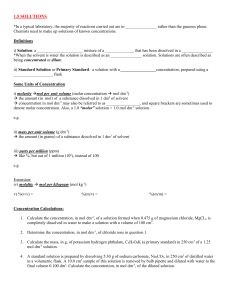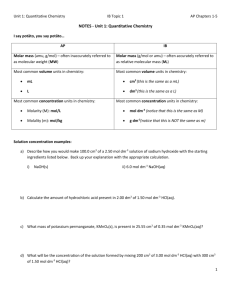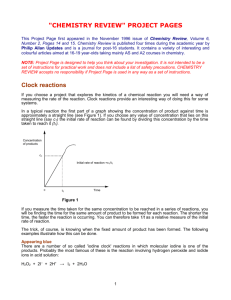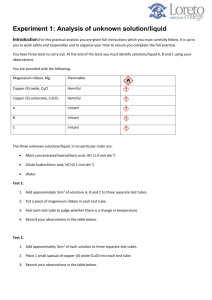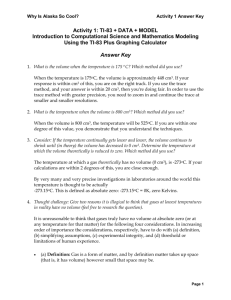Adsorption and inclusion
advertisement
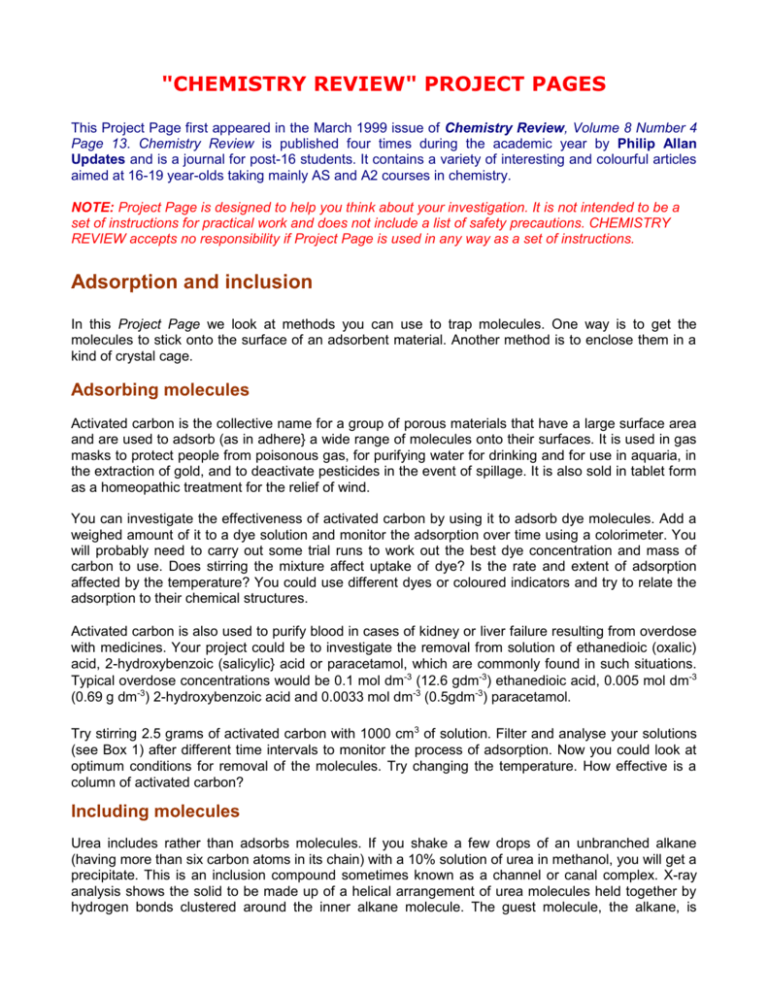
"CHEMISTRY REVIEW" PROJECT PAGES This Project Page first appeared in the March 1999 issue of Chemistry Review, Volume 8 Number 4 Page 13. Chemistry Review is published four times during the academic year by Philip Allan Updates and is a journal for post-16 students. It contains a variety of interesting and colourful articles aimed at 16-19 year-olds taking mainly AS and A2 courses in chemistry. NOTE: Project Page is designed to help you think about your investigation. It is not intended to be a set of instructions for practical work and does not include a list of safety precautions. CHEMISTRY REVIEW accepts no responsibility if Project Page is used in any way as a set of instructions. Adsorption and inclusion In this Project Page we look at methods you can use to trap molecules. One way is to get the molecules to stick onto the surface of an adsorbent material. Another method is to enclose them in a kind of crystal cage. Adsorbing molecules Activated carbon is the collective name for a group of porous materials that have a large surface area and are used to adsorb (as in adhere} a wide range of molecules onto their surfaces. It is used in gas masks to protect people from poisonous gas, for purifying water for drinking and for use in aquaria, in the extraction of gold, and to deactivate pesticides in the event of spillage. It is also sold in tablet form as a homeopathic treatment for the relief of wind. You can investigate the effectiveness of activated carbon by using it to adsorb dye molecules. Add a weighed amount of it to a dye solution and monitor the adsorption over time using a colorimeter. You will probably need to carry out some trial runs to work out the best dye concentration and mass of carbon to use. Does stirring the mixture affect uptake of dye? Is the rate and extent of adsorption affected by the temperature? You could use different dyes or coloured indicators and try to relate the adsorption to their chemical structures. Activated carbon is also used to purify blood in cases of kidney or liver failure resulting from overdose with medicines. Your project could be to investigate the removal from solution of ethanedioic (oxalic) acid, 2-hydroxybenzoic (salicylic} acid or paracetamol, which are commonly found in such situations. Typical overdose concentrations would be 0.1 mol dm-3 (12.6 gdm-3) ethanedioic acid, 0.005 mol dm-3 (0.69 g dm-3) 2-hydroxybenzoic acid and 0.0033 mol dm-3 (0.5gdm-3) paracetamol. Try stirring 2.5 grams of activated carbon with 1000 cm3 of solution. Filter and analyse your solutions (see Box 1) after different time intervals to monitor the process of adsorption. Now you could look at optimum conditions for removal of the molecules. Try changing the temperature. How effective is a column of activated carbon? Including molecules Urea includes rather than adsorbs molecules. If you shake a few drops of an unbranched alkane (having more than six carbon atoms in its chain) with a 10% solution of urea in methanol, you will get a precipitate. This is an inclusion compound sometimes known as a channel or canal complex. X-ray analysis shows the solid to be made up of a helical arrangement of urea molecules held together by hydrogen bonds clustered around the inner alkane molecule. The guest molecule, the alkane, is physically imprisoned lengthways in the cylindrical channels of the crystalline structure of the host molecule, urea. Your project might be to investigate the optimum conditions for the formation of the inclusion compound or to find out its composition. A neat method of analysis is to air-dry your precipitate, weigh it and then add it to a little water in a narrow-bore burette. The water dissolves the urea and the alkane floats to the surface so that you can measure its volume. Inclusion compounds of this kind are also formed between urea and alcohols with a seven or longer carbon chain, acids with at least five carbon atoms and some esters. Branched or cyclic isomers do not form a precipitate with urea and so can be separated from a mixture with unbranched molecules. You should find these adsorbing and inclusive projects quite absorbing and exciting! Box 1 Methods of analysis Ethanedioic acid Acidify the sample with dilute sulfuric acid, heat to 60 oC and titrate with 0.02 mol dm-3 potassium manganate(VII) solution. 2-hydroxybenzoic acid Titrate the sample with sodium hydroxide solution using phenolphthalein indicator or use a colorimetric technique based on the intense purple colour produced with iron(III) ions. (See CHEMISTRY REVIEW, Vol. 6, No. 3, p. 19) Paracetamol To 1 cm3 of sample add 1 cm3 6 mol dm-3 hydrochloric acid and 2 cm3 10% sodium nitrate(III) solution. Leave the mixture to stand for 2 minutes before adding 2 cm3 15% sulfamic acid and 5 cm3 2.5 mol dm-3 sodium hydroxide solution. A yellow colour is formed, stable for 2 hours, whose intensity you can measure using a colorimeter. Derek Denby Derek Denby teaches chemistry at Franklin College, Grimsby. The original article was written by Derek Denby. We are grateful to Derek for allowing us to reproduce it here. This page is free for your personal use, but the copyright remains with Philip Allan Updates. Please do not copy it or disseminate it in any way. Chemistry Review is indebted to Don Ainley, who has helped to prepare this article for the Web.




